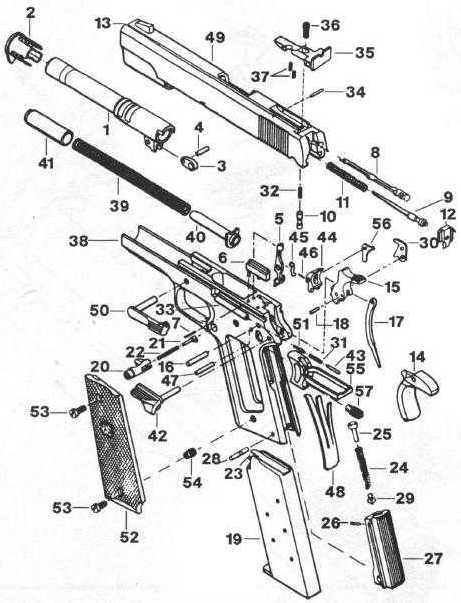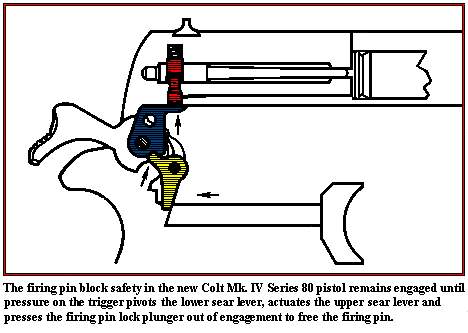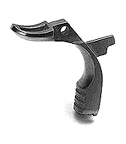Understanding Colt 1911 parts
Don't feel bad if you're one of the people who look at something like the picture to the right and see nothing but mumbo jumbo. A lot of people have a hard time making heads or tails of firearm schematics. This page is to help alleviate (for an M1911, at least) some of that confusion and frustration. Becoming more familiar with these parts, their purposes, and how they function is also an excellent safety tool.
While it does not go into detail for each and every part, it should be a good enough overview for most owners/operators of a 1911 or one of its variants.
[edit] Main parts
- 1 - the barrel
Where the bullet comes out; also known as The Dangerous End. At the rear of the barrel, is the chamber, where the cartridge is loaded. In the M1911, the cartridge headspaces by the cartridge rim. The lower part of the entrance of the chamber is throated, to make it easier for the cartridge to get into the chamber. This is an area that usually needs some polishing when customizing the gun or when a new gun is treated for reliability. This area is also a part of 1911 which has been criticized for not giving enough support to the cartridge walls during firing.
To improve things, some clever folks have produced barrels with a different feed ramp, which better supports the cartridge walls However, these barrels require some modification to the frame, which can be a bad thing, especially you're a stickler for preservation.
The barrel is held inside the slide by the barrel bushing in the front (see the next part). It is also locked in a constant position in the slide, by the slots there are at the rear top part of the barrel (which you can see in the picture) and which mate to reciprocal slots in the slide (which you can't, but trust me, they're there) when the slide is at its normal, forward position. As the gun is fired, the slide moves back, and down, due to the barrel link. This movement unlocks the barrel from the slide, opening the breech and allowing the extraction of the used cartridge case and feeding of a new round.
- 2 - the barrel bushing
The barrel bushing is used to lock the front part of the barrel in a consistent position in relation to the slide. The barrel bushing locks into the slide and allows the barrel to move in it, as the slide moves back and forth, when the action cycles. A tight bushing is an absolute must-have for accuracy but it shouldn't be excessively tight, in order to avoid jams.
- 3 & 4 - the barrel link and the barrel link pin
The barrel link is a small kidney-shaped part that links the barrel with the slide stop, and is free to move at both ends. As a result, when the slide moves back the link lowers the rear end of the barrel and unlocks the barrel from the slide, allowing the extraction of the fired case and the feeding of a new cartridge. The barrel link is a very important part, as it should be of proper length, in order to assure the correct locking of the barrel into the slide. At least 4-5 different lengths are available. The barrel link pin is what secures the barrel link onto the lower part of the barrel and allows the link to move.
- 5 - the disconnector
The disconnector is a safety device that, when functioning properly, does not allow the gun to be fired unless it is in its upper position. When the slide is in its forward position, the disconnector protrudes above its recess in the frame, into a small crescent-shaped recess in the slide. When the slide moves back, the disconnector is pushed down, disconnecting the trigger mechanism and disallowing firing. A faulty disconnector is dangerous, as it can allow the gun to fire before the slide is in its full forward position, which means before the slide and the barrel are properly locked!
- 6 - the ejector
This is the part where the fired cartridge shell is driven onto, so that it is pushed away from the face of the slide, towards the opening of the slide and out of the gun. The face of the ejector needs to be properly shaped, in order to have the spent cases ejecting correctly from the gun. The ejector is held in the frame with a tiny pin.
- 8 - the extractor
This is the part that grabs the rim of the cartridge case as this is stripped from the magazine (see below) and fed into the barrel mouth. The rim stays under the claw of the extractor until the cartridge is fired, when, as the slide moves back, the extractor pulls the cartridge out of the chamber. As the slide continues its rearward movement, the cartridge case strikes the ejector face and is popped free from the extractor and ejected outside the gun.
- 9 - the firing pin
- 10 - the firing pin plunger
Part of the new safety mechanism. This part is pushed upwards by a link in the trigger mechanism, against a small spring. By moving up, it frees the firing pin to move forward.
- 11 - the firing pin spring
A spring, the force of which the firing pin moves against when hit by the hammer. The firing pin spring has to be in excellent condition, especially in pre-Series 80 guns, as the gun can fire if it receives a blow in the front of the slide hard enough to move the firing pin forward. Several manufacturers produce replacement springs of good quality.
- 12 - the firing pin stop
This is the part that holds the firing pin in its recess.
- 14 - the grip safety
A device used to stop the gun from firing unless it is firmly held in the shooters hand. The grip safety is depressed by the web of your hand as you grasp the gun. In the rest position, the safety's arm is resting against the rear of the trigger, preventing any rearward movement of the trigger. When the shooter grabs the gun, this arm moves up outside the trigger's path, allowing the trigger to disengage the sear from the hammer and allowing the hammer to fall forward and hit the firing pin. This feature is a characteristic of the M1911 pistol, although John Browning ditched it from his design in the Browning Hi Power/P-35.
- 15 - the hammer
The hammer is the part which strikes the firing pin to set off the cartridge. When the hammer is cocked, it is under the force of the mainspring, which pushes it forward. However, it is still stopped by the sear, which is engaged with the hammer. But when the trigger is pulled, the sear is pulled away from the hammer and the hammer falls forward, striking the firing pin, which ignites the primer, which ignites the powder in the cartridge. As the powder burns, the expanding gazes push the slide backwards, cocking the hammer again. The area where the sear engages the hammer can easily be polished by a gunsmith in order to improve trigger pull.
- 17 - the hammer strut
The hammer strut transmits the energy of the mainspring to the hammer. It's a simple strut connected to the hammer with the Hammer Strut Pin (18), with its lower end resting on the Mainspring Cap (25).
- 19 - the magazine
The 1911 magazine is a single-stack magazine holding 7 or 8 rounds. The bottom of factory magazines is welded to the magazine body but there are also third party mags with removable base plates. Its follower has a special protrusion that activates the Slide Release Lever (50), locking the slide open, when the last round is fired. During the 90s, M1911 pistols with larger capacity magazines were introduced which could carry up to 13 or 14 rounds of .45 cartridges. These pistols, perhaps inevitably, get called "high capacity pistols," and there are at least two companies that produce them today: Para Ordnance (which produces high capacity metallic frames) and STI Inc. (which produces its own plastic high capacity frame). The frames of these guns are only slightly wider than the normal M1911, due to either very thin stocks or the stocks being molded on the frame itself, thus offering increased capacity without an extremely wide grip.
- 24 - the mainspring
This is the spring that pushes the hammer forward. It is kept inside the Mainspring Housing (27), at the rear of the frame and it has the Mainspring Cap (25) on its top. The Mainspring, the Mainspring Cap (25) and the Mainspring Housing Pin Retainer (29) are held inside the Mainspring Housing by the Mainspring Cap Pin (26).
- 27 - the mainspring housing
The lower rear part of the frame, which contains the Mainspring, the Mainspring Cap (25), the Main Spring Cap Pin (26) and the Main Spring Housing Pin Retainer (29). It is held in its place by the Mainspring Housing Pin (28), which is usually inserted from the left part of the frame. The Mainspring Housing can come in either flat or arched configurations and the user can select the one most comfortable for their hand. Most production pistols come with plastic mainspring housings, while those produced by most gunsmiths have metallic housings.
- The Plunger Assembly
The plunger assembly is the tube that you see on the left part of the gun, right behind the Slide Stop and forward of the thumb safety, sometimes partially covered bu the left grip panel. It consists of the plunger tube, the plunger levers (slide stop and safety lock plungers) and the plunger spring. Its role is to exercise some pressure on certain areas of the Slide Stop and Thumb Safety, in order to securely keep them at their correct positions. Some people do a small dimple at the face of the slide stop on which the plunger lever acts, in order to keep the slide stop from moving upwards, unless it is pushed by the magazine follower.
- 39 - the recoil spring
A large spring, under the barrel, which is used to reduce the velocity of the slide (a very hand feature) as it moves rearwards under the pressure of the expanding gazes produced when a cartridge is fired. Springs can vary somewhat as far as their tension is concerned.
- 40 - the recoil spring guide
This part is located underneath the barrel. In its normal (at rest) position, it is pushed rearwards by the Recoil Spring. Some people prefer to change the short Recoil Spring Guide (that comes with most M-1911s) with full length guides — the principle being that such a device doesn't allow the recoil spring to flex as it is compressed, thus offering more consistent lockup position every time the gun fires.
- 41 - recoil spring plug
This is the part that keeps the Recoil Spring inside the slide. It can be seen, below the barrel, in the front part of the gun, held in place by the Barrel Bushing. The standard part is closed in the front. If a full length guide is used (see above), then that plug is open in the front, so that the guide can move forward in it.
- 42 - the safety lock (aka thumb safety)
This is the part that allows the shooter to put his gun on "safe." If pushed upwards, it blocks the movement of the sear, preventing the gun from firing. They are usually found in only two varieties: left-side-only (the most common) or ambidextrous devices that can be operated from both sides.
- 44 - the sear
This is what keeps the hammer from going forward until the trigger is pulled. The sear has a special edge which engages to a recess in the hammer, preventing it from going forward. When the trigger is pulled, the sear is pushed away from the hammer, disengaging it and allowing it to fall forward. In case the sear disengages from the hammer without the trigger being at the rear of its travel, there is one additional notch on the hammer, called the half-cock notch, that the sear will catch, thus preventing an accidental discharge. DO NOT ALTER OR ELIMINATE the half-cock notch from your hammer! This is dangerous and can easily lead to accidental discharges! The half-cock notch of some hammers does not allow the hammer to fall forward, even if the trigger is pulled (I consider this a plus), while others allow the release of the hammer if the trigger is pulled (I consider this not a plus). (Note: if your pistol is a Colt Gold Cup, there are two additional parts involved in the sear mechanism.)
- 48 - the sear spring
A three-prong (or sometimes a four-prong) flat spring, which exerts pressure on the sear, the trigger and disconnector, and the grip safety of the gun. Its role is therefore three-fold:
- a) to push the trigger forward, against shooter's finger,
- b) to push the sear, so that it is constantly pushing against the hammer, and at the same time push the disconnector up, and
- c) to push the grip safety backwards, against the pressure of the gripping hand.
If a four-prong spring is used, there are separate prongs for the sear and the disconnector, in order to improve trigger feel.
- 49 - the slide (like you needed to be told)
The slide is the upper part of the gun. It contains the firing pin, the firing pin spring, barrel, barrel bushing, extractor, part of the firing pin safety mechanism, the front/rear sights, and a partridge in a pear tree. The slide is attached to the frame in two rails on the side of the frame. In the M1911, the slide is embracing the frame, unlike some 9mm pistols (like the CZ-75) where the frame embraces the slide.
- 50 - the slide stop
The slide stop is used to keep the slide locked in its rear/open position, either manually or when the gun fires the last round in the magazine. In this last case, the follower of the magazine pushes the slide stop upwards, locking the slide at the rear. The slide stop is also linked to the Barrel Link (3), creating the rearward and downward movement of the barrel when the slide moves backward.
- 52 - the grips
The grips can be either wood, rubber, plastic, mother-of-pearl, or any one of a number of other substances (trust us, there are a lot of them). They are a cosmetic but also a functional part of the gun. Some shooters prefer rubber grips as they allow a better grip of the gun — others claim that rubber grips don't allow the hand to slide on them, so they prevent the shooter from obtaining a good grip when in a hurry (which can be a major consideration in competitions). The stocks are held on the gun by the Stock Screws (53) - normally slotted but some have been using Allen heads lately. The screws attach themselves to the Stock Screw Bushings (54).
- The magazine catch assembly
The part that you push to eject a magazine. It consists of the magazine catch (20), the magazine catch lock (21) and the magazine catch spring (22). It is used to keep the magazine securely in the gun until it is pressed, when the magazine is allowed to freely fall out of the gun.
- 38 - the frame (receiver)
The most basic part of a gun. It is the part of the gun that you hold in your hand and in which the magazine is inserted when loading the gun. In the M1911, the frame also contains the trigger mechanism and the thumb and the grip safety mechanisms.
- 55 - the trigger
The M1911 trigger consists of two parts: the finger pad, which is what protrudes from the gun frame and is pushed rearwards by the shooter's finger, and the bow, which is the part that transfers the finger's motion to the sear. The bow consists of a piece of metal, shaped like the Greek capital letter Delta (Δ, if you have Greek fonts on your PC). In this way, the magazine can be inserted between the two sections of the bow, without interfering with the trigger functioning.
[edit] See also
[edit] External links
- STI has made probably the best animation ever of the internal workings of the 1911. Seriously, check this out!


